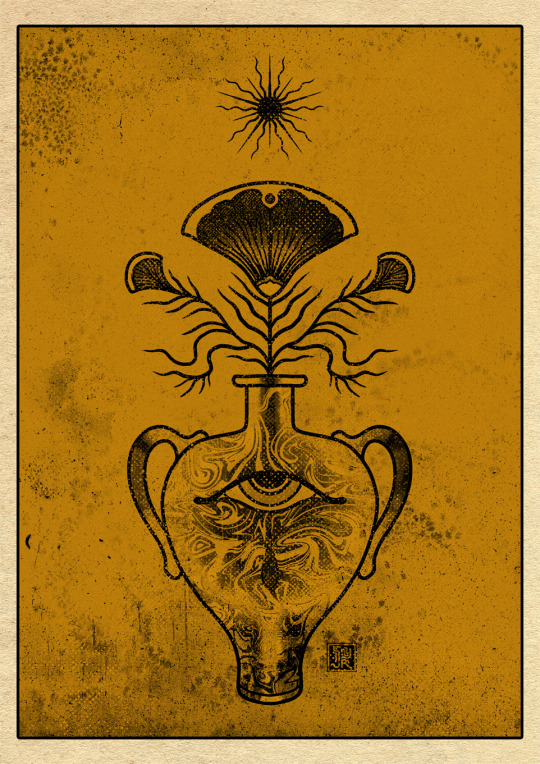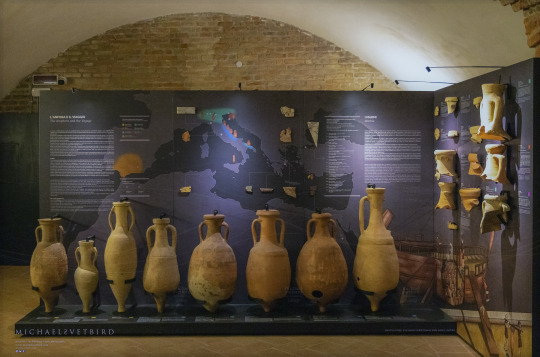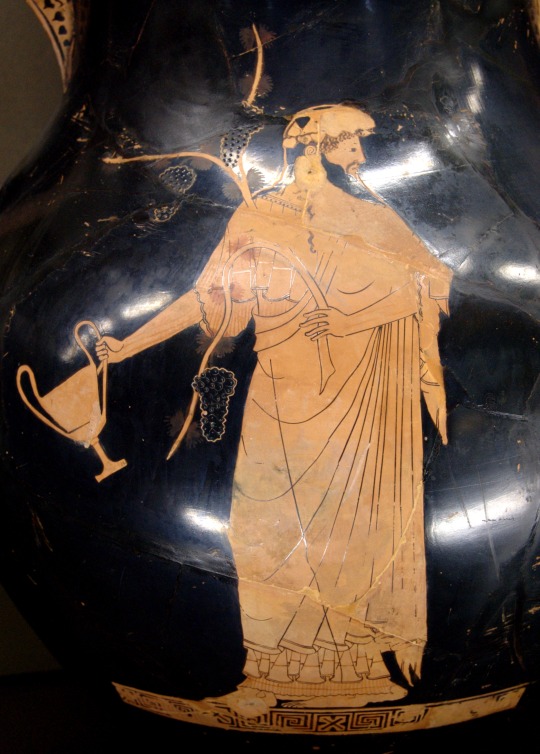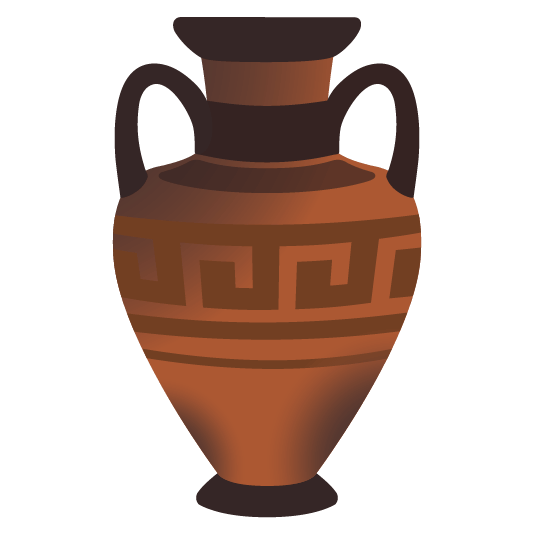#amphorae
Text

Sea encrusted amphora necklace
#moon and serpent#amphora#amphorae#sea witch#ancient greek#ancient roman#archaeology#artefact#artifact#mermaidcore
575 notes
·
View notes
Text
Archaeologists discovered an intact Etruscan tomb in the necropolis of Vulci, Italy. The double-chambered tomb is filled with exquisite artifacts offering insights into the affluent Etruscan culture and its international wine trade in the 7th-century BC.
#burials#tombs#Vulci#necropolis#Italy#amphorae#Etruscan#pottery#elite#chambers#ancient#history#ancient origins
54 notes
·
View notes
Photo

#amphorae#amphora#Digital Illustration#illustration#digitalart#ownart#artwork#artistsontumblr#flowers#flowerillustrations#sun
341 notes
·
View notes
Text




PIACENZA Last Saturday 14|10:
Civico Museo Archeologico | Palazzo Farnese
Trade in the Mediterranean region display:
Pics 1-2
Terracotta Amphorae and Marble from around Mediterranean Sea,
2 BC. to 2 AD.
Pics 3-4
Terracotta Dolium,
1 BC. - 1st-half of 1 AD.
Found in Travo near Piacenza in 1860.
Archaeological Museum of Piacenza in Palazzo Farnese | CMAP
• Web : https://www.palazzofarnese.piacenza.it/en/page/museo-archeologico-1
• FB : https://www.facebook.com/palazzofarnese.piacenza
• IG : @palazzofarnese.piacenza
CMAP | Michael Svetbird phs©msp | 14|10|23 6200X4100 600 [I.-III.]
The photographed objects are collection items of CMAP, photos are subject to copyrights.
[non commercial use | sorry for the watermarks]
#piacenza#palazzo farnese#palazzo farnese piacenza#archaeological museum#ancient pottery#ancient ceramics#terracotta#pottery#vessel#amphora#amphorae#dolium#mediterranean#mediterranean sea#ancient trade#antiquity#archaeology#archeologia#museology#museums#heritage#ancient#antiquities#ancient history#ancient culture#ancient world#art photography#archaeology photography#museum photography#michaelsvetbird
7 notes
·
View notes
Text
Very interesting, particularly because they were found on the seabed, and you wouldn't expect anything to have survived in that wet environment. Perhaps the salinity helped?
15 notes
·
View notes
Text

Untitled, 18/6/22
#leicaq2monochrom#black and white#john perivolaris#summilux#silver efex pro 2#pots#pottery#summilux f.17 28mm#aegean#greek islands#Armolia#chios#amphorae#diagonal#europe#civilisation#hand crafted#clay#Lines#Rows#mediterranean#monochrome#outdoors#popular culture#Shadows
2 notes
·
View notes
Text
El pecio Bou Ferrer: un naufragio en la época de Nerón.
The Bou Ferrer wreck: a shipwreck in Nero's time.
(Español / English)
En 1999, dos buceadores deportivos, José Bou y Antoine Ferrer, hallaron los restos de un navío mercante romano, cargado con miles de ánforas, que se hundió en las costas de la localidad alicantina de Villajoyosa en algún momento del siglo I.
En abril del año 2000, Bou y Ferrer comunicaron su descubrimiento al Museo Municipal de Villajoyosa y entregaron las fotografías que habían realizado. El museo informó al Centro de Arqueología Subacuática de la Comunidad Valenciana, que tomó cartas en el asunto y en enero de 2001 encargó a los arqueólogos Carlos de Juan y Gustavo Vivar que acudiesen al enclave con los descubridores; pero cuando Bou y Ferrer se sumergieron vieron enseguida que no se hallaba en el mismo estado. Sin duda, se había difundido la voz del hallazgo y en los meses anteriores otros buceadores habían sustraído un gran número de ánforas. Los arqueólogos, alarmados, cobraron conciencia de que si no se ponía freno al expolio el yacimiento desaparecería en poco tiempo.
En mayo de 2001 se puso en marcha un proyecto de protección que preveía la colocación de una estructura sobre el cargamento de ánforas. En 2006, un equipo dirigido por Carlos de Juan y Franca Cibecchini emprendió las excavaciones en el pecio, que recibió el nombre de sus descubridores: Bou Ferrer.
Los arqueólogos constataron que se trataba de una nave romana de unos treinta metros de eslora, lo que la convertía en el mayor barco romano en excavación de todo el Mediterráneo. El navío llevaba un enorme cargamento de ánforas, de las que hasta la fecha se han localizado unas tres mil. Cada una contenía 40 kilos de salsa de pescado elaborada con boquerón, caballa y jurel (garum).
Las ánforas fueron colocadas en la bodega del navío entre sarmientos de vid para su protección durante el transporte. A ambos lados de la sobrequilla se localizaron doce lingotes de plomo de sierra Morena, de 64 kilos cada uno, con la contramarca "Emperador Germánico Augusto", por lo que los arqueólogos han podido datar el pecio en el siglo I d.C. También la madera del barco se hallaba en un excelente estado de conservación, lo que ha permitido estudiar su técnica constructiva.
En un estudio publicado en 2014 se llegó a la conclusión de que el navío se construyó en algún astillero de la zona de Neápolis (la actual Nápoles).
Es posible incluso reconstruir de modo bastante fiable la historia del naufragio del Bou Ferrer. El navío zarpó a mediados del siglo I de algún puerto cerca de Cádiz, con destino posiblemente a Roma o a Narbona, con su valioso cargamento de ánforas y lingotes.
Tal vez en su tránsito hacia las Baleares tuvo problemas y, en un intento por salvarse, la tripulación hizo una maniobra de aproximación a la costa a favor del viento. Pero la tentativa resultó fallida y el pesado barco mercante romano naufragó a escasos mil metros de la costa, donde ha yacido imperturbado durante casi dos milenios.
Fuente texto: historia.nationalgeographic.com.es
__________________________________
In 1999, two sport divers, José Bou and Antoine Ferrer, found the remains of a Roman merchant ship, loaded with thousands of amphorae, which sank off the coast of the Alicante town of Villajoyosa sometime in the 1st century.
In April 2000, Bou and Ferrer communicated their discovery to the Villajoyosa Municipal Museum and handed over the photographs they had taken. The museum informed the Centre for Underwater Archaeology of the Valencian Community, which took action and in January 2001 commissioned archaeologists Carlos de Juan and Gustavo Vivar to go to the site with the discoverers; but when Bou and Ferrer dived they saw immediately that it was not in the same state. Undoubtedly, word of the discovery had spread and in the previous months other divers had stolen a large number of amphorae. The archaeologists were alarmed and realised that if the plundering was not stopped, the site would soon disappear.
In May 2001, a protection project was launched, which foresaw the placement of a structure over the amphorae cargo. In 2006, a team led by Carlos de Juan and Franca Cibecchini undertook excavations on the wreck, which was named after its discoverers: Bou Ferrer.
The archaeologists found that it was a Roman ship of some thirty metres in length, making it the largest Roman ship excavated in the Mediterranean.The ship was carrying an enormous cargo of amphorae, of which around three thousand have been found to date. Each one contained 40 kilos of fish sauce made from anchovies, mackerel and horse mackerel (garum).
The amphorae were placed in the hold of the ship between vine shoots for protection during transport. Twelve lead ingots from Sierra Morena, weighing 64 kilos each, with the countermark "Emperor Augustus Germanicus" were found on both sides of the overpack, so archaeologists have been able to date the wreck to the 1st century AD. The wood of the ship was also in an excellent state of preservation, which has allowed them to study its construction technique.
A study published in 2014 concluded that the ship was built in a shipyard in the area of Neapolis (present-day Naples).
It is even possible to reconstruct quite reliably the story of the shipwreck of the Bou Ferrer.The ship set sail in the mid-1st century from a port near Cadiz, possibly bound for Rome or Narbonne, with its valuable cargo of amphorae and ingots.
Perhaps in its transit to the Balearic Islands it had problems and, in an attempt to save itself, the crew made a manoeuvre to approach the coast downwind. But the attempt was unsuccessful and the heavy Roman merchant ship was wrecked barely a thousand metres from the coast, where it has lain undisturbed for almost two millennia.
#roman ship#1st century#shipwreck#amphorae#ánforas#bou ferrer#naufragios#pecio romano#s. 1 d.C.#wreck
1 note
·
View note
Text

landscape.155, vapor escape
Ancient containment devices proved impermanent.
0 notes
Text
Mature BBW anal outdoor
Amiga que conheci no badoo
SOURCE???? actress with big boobs dresses up, casting
Teen Pawg Takes Black Dick
Horny blonde licks her redhead milf date
Nicole Aniston Fucked Hard HD
Sexy Cougar Suzie Q Has Her Pussy Drilled Hard
Estela Coroa e seu maravilhoso boquete
Fap Ceo Mayhem Amber reverse cowgirl penetration screen clicking
Two crossdressers sucking cock
#worse-named#tessellates#marlpit#bluecup#phyllodia#squelchiness#stewpan#nonreconciliation#hydrotasimeter#unmacerated#sterol#adorers#noncalcareous#untypically#miscounseling#amphorae#gray-bearded#enchanted#abrasing#blindball
0 notes
Text
Picture an epic ship, lost in the Aegean Sea's abyss for millennia. The Dokos shipwreck is the oldest known shipwreck found. This remarkable archaeological gem offers a glimpse into an era of seafaring, trade, and tales of adventure.
49 notes
·
View notes
Text


AN ATTIC BLACK-FIGURED NECK-AMPHORA AND LID
CIRCA 510 B.C.
#AN ATTIC BLACK-FIGURED NECK-AMPHORA AND LID#CIRCA 510 B.C.#pottery#ancient pottery#ancient artifacts#archeology#archeolgst#history#history news#ancient history#ancient culture#ancient civilizations#ancient greece#greek history#greek art
458 notes
·
View notes
Text

The god Dionysos, holding a kantharos (two-handled drinking cup) in his right hand and a grapevine in his left. Side A of an Attic red-figure amphora attributed to the Berlin Painter and dated between 490 and 480 BCE. Found at Vulci; now in the Louvre.
#classics#tagamemnon#Ancient Greece#Greek religion#Ancient Greek religion#Hellenic polytheism#Dionysus#Dionysos#art#art history#ancient art#Greek art#Ancient Greek art#vase painting#red-figure#amphora#Berlin Painter#Louvre#Louvre Museum#Musee du Louvre
474 notes
·
View notes
Text

I have finished the colourwork for my greek pottery inspired cardigan! Next step is gentle blocking, then into steeking, and finally finishing of the edges and button band. The pattern is Greek Amphora Cardi and this is the same cardigan that the Roomba tried to eat back in the fall.

Bonus image of all my floats. I am very happy with how it has been turning out. Took ages to sew in all the ends on the sleeves. Very glad I decided on the second sleeve to leave the longer floats between motifs and save on ends to weave in.
#knitting#knitting wip#wip knitting#greek inspired#greek pottery inspired#greek designs#cardigan#cardigan wip#greek#Greek Amphora Cardi#Not too bad for my second ever knitted sweater#I really like colourwork and learned knitting after running into constraints from crochet colourwork
158 notes
·
View notes
Text


Amphora by Moon and Serpent
#moon and serpent#handmade jewelry#support artists#amphora#antique#ancient#greek goddess#greek mythology#roman history#ancient rome#ancient greece#earrings#necklaces#pendants#gift#archaeology#artisanal
420 notes
·
View notes





